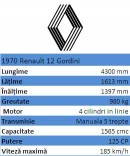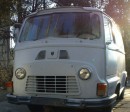← Continued from Page 1 of "From Dacia 1300 to Dacia Logan/Duster. The History of a Controversial Brand"By 1972, 45,000 Dacia 1100 cars had been made, while the model received a minor facelift to the front side in 1970. A special version was produced as well, called 1100s, with two pairs of headlights and a more powerful engine (65HP, 90mph maximum speed). It was a very limited edition and it was only used by the police and for some car racing competitions at that time.
On August 23rd 1969 (a day of resounding importance for Romanian communists) marked the production start for the real Dacia, the one who eventually became a cornerstone in local automotive history. Based on the Renault 12, Dacia 1300 was showcased at the Bucharest and Paris auto shows and presented as a real masterpiece. A victory of socialism, an outstanding achievement of the beloved leader.
Dacia 1300 got very quickly into the Romanians’ conscience and became a national symbol, hated and adored at the same time. It was a simple, rudimentary sedan with front wheel drive and front-mounted engine, just like Ceausescu liked them. The engine had a 1289 cm3 displacement, burned about 10l of fuel per 100Km, polluted like an Airbus and produced about 54HP in its better days. The maximum speed was, in theory, 90mph.
Advanced models came about in 1970: Dacia 1300L (L from Luxury) and Dacia 1300LS (Luxury Super) also known as Dacia 1301 and available exclusively for high-ranking politicians who apparently wanted something better than what the “beloved leader” had devised.
A hatchback called Dacia 1200 is also launched.
1973 brought over the wagon model which was a longer, more comfortable and more spacious Dacia 1300, ideal for the “idiots” who had a lot of heavy stuff to cart around in their cars. This was probably the reason for which the Dacia 1302 came into existence in 1975. Being essentially a Dacia 1300 wagon with substantially firmer rear suspension, it was perfect for transporting even more stuff.
By now, you’re probably starting to notice the root of the giant car boot obsession and the reason for the huge cave opening at the rear of any Dacia model, even the current ones, for example the Logan.
It’s interesting to note the wagon model was a real market success. In fact, over 2 million Dacias were produced, something that probably alarmed even the makers of the famous Trabant, from the eastern and (still) communist part of Germany. A great many of these wagons were exported at that time to... Algeria.
This model went on to become the foundation for specialized versions for use in the army, as ambulances and other national services which required modified and adapted cars, with or without rear seats, with custom equipment and so on.
1975 is the birth year of a very special model in Dacia’s history. Based on the Renault Estafette, the newly launched D6 was the first van ever made in Romania under the Dacia brand. Unfortunately, even though Renault’s model was quite a rage in France, only 842 Dacia D6 were produced in Romania.
Some say this was done to avoid competing with the original model but others, and I’m tempted to side with them, believe the real reason was that this type of car was widely adopted and sought after by youngsters embracing the hippy trend, something that was objectionable for a communist regime, leading in the cancellation of the D6 in 1978 by explicit order of the PCR (The Romanian Communist Party).
On August 23rd 1969 (a day of resounding importance for Romanian communists) marked the production start for the real Dacia, the one who eventually became a cornerstone in local automotive history. Based on the Renault 12, Dacia 1300 was showcased at the Bucharest and Paris auto shows and presented as a real masterpiece. A victory of socialism, an outstanding achievement of the beloved leader.
Dacia 1300 got very quickly into the Romanians’ conscience and became a national symbol, hated and adored at the same time. It was a simple, rudimentary sedan with front wheel drive and front-mounted engine, just like Ceausescu liked them. The engine had a 1289 cm3 displacement, burned about 10l of fuel per 100Km, polluted like an Airbus and produced about 54HP in its better days. The maximum speed was, in theory, 90mph.
Advanced models came about in 1970: Dacia 1300L (L from Luxury) and Dacia 1300LS (Luxury Super) also known as Dacia 1301 and available exclusively for high-ranking politicians who apparently wanted something better than what the “beloved leader” had devised.
A hatchback called Dacia 1200 is also launched.
1973 brought over the wagon model which was a longer, more comfortable and more spacious Dacia 1300, ideal for the “idiots” who had a lot of heavy stuff to cart around in their cars. This was probably the reason for which the Dacia 1302 came into existence in 1975. Being essentially a Dacia 1300 wagon with substantially firmer rear suspension, it was perfect for transporting even more stuff.
By now, you’re probably starting to notice the root of the giant car boot obsession and the reason for the huge cave opening at the rear of any Dacia model, even the current ones, for example the Logan.
It’s interesting to note the wagon model was a real market success. In fact, over 2 million Dacias were produced, something that probably alarmed even the makers of the famous Trabant, from the eastern and (still) communist part of Germany. A great many of these wagons were exported at that time to... Algeria.
This model went on to become the foundation for specialized versions for use in the army, as ambulances and other national services which required modified and adapted cars, with or without rear seats, with custom equipment and so on.
1975 is the birth year of a very special model in Dacia’s history. Based on the Renault Estafette, the newly launched D6 was the first van ever made in Romania under the Dacia brand. Unfortunately, even though Renault’s model was quite a rage in France, only 842 Dacia D6 were produced in Romania.
Some say this was done to avoid competing with the original model but others, and I’m tempted to side with them, believe the real reason was that this type of car was widely adopted and sought after by youngsters embracing the hippy trend, something that was objectionable for a communist regime, leading in the cancellation of the D6 in 1978 by explicit order of the PCR (The Romanian Communist Party).









